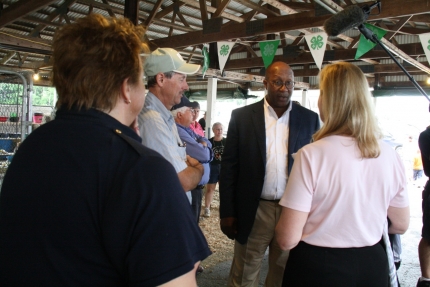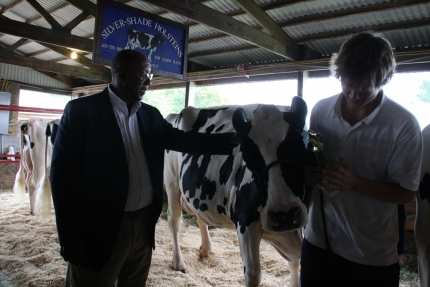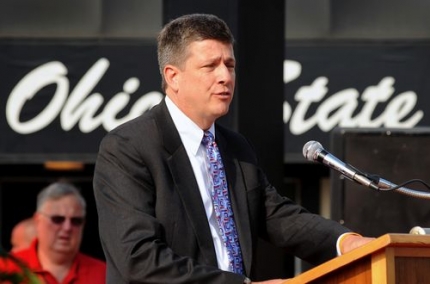White House Rural Council Blog
Iowa State Fair: America’s Heartland at its Best
Posted by on August 18, 2010 at 5:45 PM EDTI’ve spent the last few days here in Iowa, a state that I was honored to serve as Governor for eight years. Yesterday, I walked the grounds of the Iowa State Fair in Des Moines. The fair is refreshingly the same each year, but also a snapshot of changing rural America. The food stands, midway and cattle barns are in the same place that they’ve been for years. We’ve sculpted a "Butter Cow" since the early 1900s, but now the young people all have iPods and Blackberry phones. Their parents have cell phones.
Like the state fair, rural America is changing each year in subtle ways. Many of our grandparents and great grandparents made their homes on small farmsteads and made their living directly from the land. Today, farming is more mechanized. Farms are larger, and fewer Americans call them home. Most people who live in small towns in rural America still feel connected to the land, but they don’t necessarily depend on it for their livelihood. The demands of rural America are changing, along with the drivers of the rural economy.
While at the fair, I participated in a roundtable on rural revitalization. The roundtable discussion featured some of Iowa’s top rural leaders, including Iowa Farm Bureau President Craig Lang. We discussed our vision for developing a new, strong, vibrant rural economy; one that supports food production, but also generates renewable energy while safeguarding our environmental heritage. To help drive this rural renaissance, the Obama Administration supports quality health care and educational opportunities for all Americans, availability of broadband, and safe, sanitary rural housing. It’s what rural America wants.
At USDA, we are moving forward to meet the changing demands of rural America. Yesterday, I announced a major USDA investment toward the Administration’s goal: loans and grants to allow farmers, ranchers, business owners and producers improve energy efficiency, develop renewable energy and cut costs. Today, I will join Commerce Secretary Locke in announcing additional projects to bring broadband to rural America.
While USDA is adapting to meet the expanding needs of all of rural America, our primary purpose remains the same: to help those who live there prosper. Like the Iowa State Fair’s cattle barns and butter cow, some things at USDA remain constant, but we know that to remain vital to rural residents, we need to assist them when they ask for broadband and cell phone service, too.
Tom Vilsack is Secretary of Agriculture
Learn more about RuralObama Administration Officials Continue to Visit State Fairs
Posted by on August 16, 2010 at 4:30 PM EDTBuilding on the President’s commitment to address issues important to rural Americans, Cabinet Secretaries and other top Administration officials are visiting state fairs this summer and fall to discuss ongoing efforts to:
- Support job creation;
- Improve access to health care;
- Enhance the quality of rural education and;
- Help strengthen rural America by working better with communities, states and the federal government.
Cabinet Secretaries and Administration officials have been talking to 4-H and Future Farmers of America students, seeing solar panels on a stick and checking out best in show dairy cows. Read more about the State Fair visits so far:
Secretary of Education Arne Duncan visits the Delaware State Fair:
Reaching Out to Rural America: Meeting with Students at the Delaware State Fair (July 26, 2010)Deputy Transportation Secretary John Porcari visits the Ohio State Fair:
Summertime Means Construction, Jobs for Ohioans (July 28, 2010)USTR Ambassador Ron Kirk visits the Maine State Fair:
Grown Locally and Sold Globally: Creating Jobs Through Agricultural Exports (August 6, 2010)Learn more about RuralAmerican Tradition and Rural Innovation at the Wisconsin State Fair
Posted by on August 12, 2010 at 11:16 AM EDTLast week I took part in an American tradition: visiting the Wisconsin State Fair. The Wisconsin State Fair and state fairs throughout the country are a cherished summertime experience for rural America - a place where old friends and old traditions go hand-in-hand with the latest innovations. In a solar powered building, I sampled my first cheese curds. I visited Senator Herb Kohl's family's flavored milk stand and had some of the Fair's famous cream puffs. And I saw the Fair's "solar panel on a stick" - a rotating solar panel that follows the sun - an investment that has already paid for itself in utility savings.
Something else was on display as well: the value that our great outdoors and green spaces have for millions of Americans. The environment is the foundation of the economy for the farmers and ranchers I met at the fair, the people who live off the land. It's part of the culture for the women and men who love to fish and hunt. And it's a way of life for the 60 million Americans living in small towns and rural areas throughout the country. Though they may not call themselves "environmentalists," these Americans are playing an important part in protecting critical natural resources, using sustainable techniques to preserve our environment, and leading the way in innovative clean energy technology.
Grown Locally and Sold Globally: Creating Jobs Through Agricultural Exports
Posted by on August 6, 2010 at 1:27 PM EDTRecently, I’ve been traveling across the country to meet with local business leaders, workers and farmers to talk about how trade can support well-paying jobs right here at home. Yesterday I travelled to the Bangor State Fair in Maine. In its 161st year, this traditional Maine summer event was a perfect place to showcase the importance of agricultural exports to the economic recovery.
I had the opportunity to join Bangor State Fair Director Mike Dyer and USDA Rural Development State Director for Maine Virginia Manuel. With the help of Penobscott County 4-H students, I was able to see first-hand a wide selection of the great American farm products that are sold around the world. I met high school student Matt Davis and his best in show winning dairy cow. I also saw goats and chickens. College students Majorie Hardy and Haley Emery gave me a tour of the 4-H students' project area where I was able to talk with students about the importance of growing locally and selling globally.
Summertime Means Construction, Jobs for Ohioans
Posted by on July 28, 2010 at 6:41 PM EDTCross-posted from the U.S. Department of Transportation blog
Few things say summer like a state fair. And, as a graduate from the nearby University of Dayton, I was thrilled to take part in today's opening of the 157th Ohio State Fair with Governor Ted Strickland.
A proud Buckeye tradition, the Ohio State Fair has delighted locals and visitors since 1850. Last year alone, over 800,000 people turned out to take part in the livestock competitions, concerts, rides, and butter sculptures that make up a true state fair experience.
Reaching Out to Rural America: Meeting with Students at the Delaware State Fair
Posted by on July 26, 2010 at 12:49 PM EDTOn Friday, I joined Senator Tom Carper and Representative Mike Castle at the Delaware State Fair in Harrington, DE. We spent the day with 4-H and Future Farmers of America students. We saw the results of their hard work on farming vegetables, baking pastries and pies from scratch, sewing garments and tending to farm animals. The students participating in 4-H, a program run by the U.S. Department of Agriculture’s National Institute of Food and Agriculture and the National Future Farmers of America Organization, showed me first-hand the vital contributions of our nation’s rural communities.
The President is dedicated to promoting and developing the work of rural America. That’s why the American Recovery and Reinvestment Act provided $53 billion to support the ability of rural communities to gain access to the health care, educational, economic, and infrastructure development resources. To better understand the needs of rural communities, the President asked Cabinet members to visit communities across the nation on a Rural Tour. Over the last year, the Administration has engaged thousands of people in a conversation about how towns, states, and the federal government can work together to help strengthen rural America. In addition to the Delaware State Fair, I have visited remote villages in Alaska and an Indian reservation in Montana.
- &lsaquo previous
- …
- 9
- 10
- 11
- 12
- 13
- 14
- 15
- 16
- 17
- next &rsaquo
White House Blogs
- The White House Blog
- Middle Class Task Force
- Council of Economic Advisers
- Council on Environmental Quality
- Council on Women and Girls
- Office of Intergovernmental Affairs
- Office of Management and Budget
- Office of Public Engagement
- Office of Science & Tech Policy
- Office of Urban Affairs
- Open Government
- Faith and Neighborhood Partnerships
- Social Innovation and Civic Participation
- US Trade Representative
- Office National Drug Control Policy
categories
- AIDS Policy
- Alaska
- Blueprint for an America Built to Last
- Budget
- Civil Rights
- Defense
- Disabilities
- Economy
- Education
- Energy and Environment
- Equal Pay
- Ethics
- Faith Based
- Fiscal Responsibility
- Foreign Policy
- Grab Bag
- Health Care
- Homeland Security
- Immigration
- Innovation Fellows
- Inside the White House
- Middle Class Security
- Open Government
- Poverty
- Rural
- Seniors and Social Security
- Service
- Social Innovation
- State of the Union
- Taxes
- Technology
- Urban Policy
- Veterans
- Violence Prevention
- White House Internships
- Women
- Working Families
- Additional Issues




